Never miss another geomagnetic storm. Sign up for Space Weather Alerts and you'll receive a text message when magnetic storms erupt. Aurora tour guides and professional astronomers use this service. You can, too! | | |
POSSIBLE CME IMPACT: A shock wave in the solar wind hit Earth's magnetic field on Nov. 25th (0230 UT). "It wasnt much of a strike, but it was enough to make auroras here in northern North Dakota," reports Elon Gane, who photographed the display from a roadside near Mohall, ND:

"The lights were faint but clearly visible to the naked eye," says Gane.
The shock wave might have been a faint CME that left the sun on Nov. 19th, hurled in our direction by an erupting filament of magnetism. Forecast models predicted a near-miss, but a grazing impact may have happened instead. Aurora alerts: SMS Text.
Realtime Aurora Photo Gallery
Free: Spaceweather.com Newsletter
CRYOVOLCANIC ERUPTION ON A COMET: The British Astronomical Association (BAA) is reporting a new outburst of cryovolcanic comet 29P/Schwassmann-Wachmann. On Nov. 22nd, amateur astronomer Patrick Wiggins watched 29P increase in brightness by more than 4 magnitudes--a sign that a major eruption was in progress. On Nov. 23rd, André Debackère used the Faulkes Telescope North in Hawaii to photograph the expanding shell of debris:
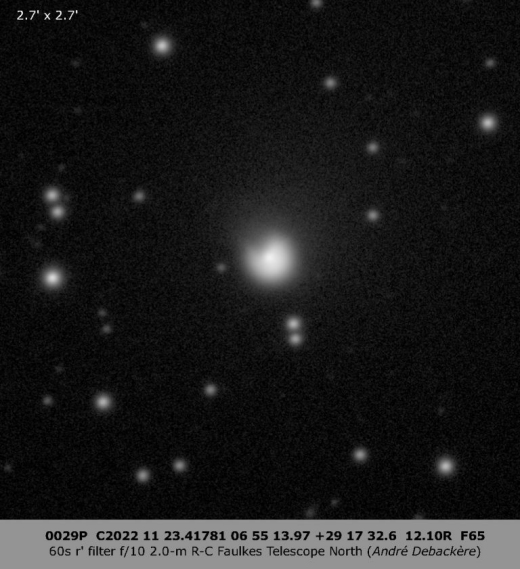
The Pac-Man shape of the ejecta shows that this is not a uniform global eruption. Instead, it is coming from one or more discrete sources on the comet's surface.
This fits a leading model of the comet developed by Dr. Richard Miles of the British Astronomical Association. Miles believes that 29P is festooned with ice volcanoes. There is no lava. The "magma" is a cold mixture of liquid hydrocarbons (e.g., CH4, C2H4, C2H6 and C3H8) akin to those found in lakes and streams on Saturn's moon Titan. The cryomagma is suffused with dissolved gases N2 and CO, much like carbonation in a soda bottle. These bottled-up volatiles love to explode when a fissure is opened by the warming action of sunlight.
A new image just taken by Cai Stoddard-Jones using the Faulkes Telescope North adds weight to the idea that a single volcano or active zone is involved. Processing the data with a rotational gradient filter, Stoddard-Jones found an intense condensation of debris at position angle 330 degrees:
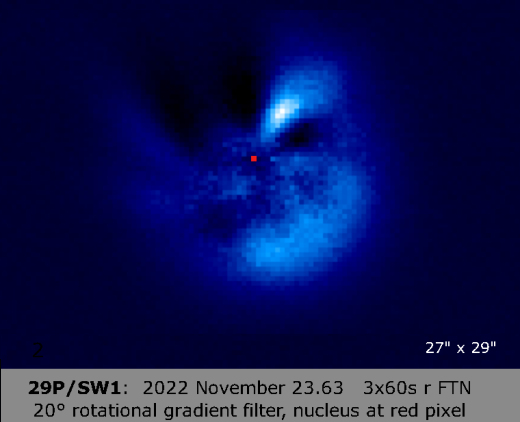
This narrow plume probably leads back to the primary source the eruption. The plume is currently streaming away from the nucleus at 75 m/s (270 km/hr) and stretches more than 11,000 km from end to end. If an eruption like this were happening on Earth, it would jut far outside our planet's atmosphere; it's huge.
These dimensions, plus the integrated brightness of the comet (magnitude +11), put 29P within easy range of many backyard telescopes. If past eruptions are any guide, Pac-Man should grow much larger in the nights ahead. Observers can find 29P after sunset in the constellation Gemini.
For more information visit the British Astronomical Association's MISSION 29P website.
Realtime Space Weather Photo Gallery
Free: Spaceweather.com Newsletter
BLACK FRIDAY AT THE EDGE OF SPACE: Christmas is coming. Are you looking for a far-out gift? Check out the Earth to Sky Store. It's filled with unique items that have flown to the edge of space onboard cosmic ray research balloons.

Carried aloft by giant helium balloons, these unique gifts have flown above 99.7% of Earth's atmosphere, experiencing space-like blasts of cosmic rays, extreme cold, and a wild ride parachuting back to Earth after the balloon explodes. Even Amazon doesn't carry items this far out.
Don't forget to enter coupon code "BLACKPEARL" at checkout for a 15% Black Friday discount.
Far Out Gifts: Earth to Sky Store
All sales support hands-on STEM education
FULL VENUS ON THANKSGIVING: Like the Moon, Venus has phases. On Thanksgiving, the second planet was full. "Venus was 99% illuminated when I photographed it on Nov. 24th," reports Kevin R. Witman, who sends this picture from Cochranville, Pennsylvania:
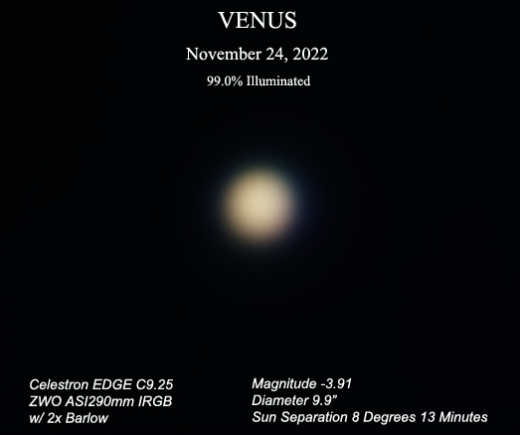
It's not easy to observe Venus when it is full. From Earth, Venus looks full when it is on the opposite side of the sun--as far from Earth as it can get and surrounded by bright sunlight.
"With Venus only 8 degrees away from the sun, it was a great challenge just to find its small disk against the very bright background sky," says Witman. "But I managed to do it using a Celestron EDGE HD C9.25 with a 2x Barlow."
Realtime Space Weather Photo Gallery
Free: Spaceweather.com Newsletter
Realtime Aurora Photo Gallery
Free: Spaceweather.com Newsletter
Every night, a network of
NASA all-sky cameras scans the skies above the United States for meteoritic fireballs. Automated software maintained by NASA's Meteoroid Environment Office calculates their orbits, velocity, penetration depth in Earth's atmosphere and many other characteristics. Daily results are presented here on Spaceweather.com.
On Nov 25, 2022, the network reported 4 fireballs.
(3 sporadics, 1 Leonid)
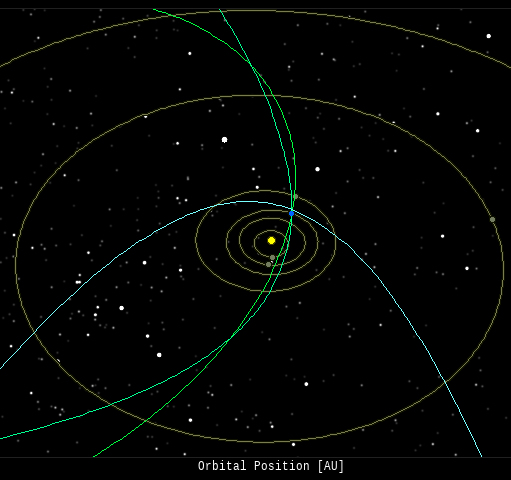
In this diagram of the inner solar system, all of the fireball orbits intersect at a single point--Earth. The orbits are color-coded by velocity, from slow (red) to fast (blue). [Larger image] [movies]
Potentially Hazardous Asteroids (
PHAs) are space rocks larger than approximately 100m that can come closer to Earth than 0.05 AU. None of the known PHAs is on a collision course with our planet, although astronomers are finding
new ones all the time.
On November 25, 2022 there were 2316 potentially hazardous asteroids.
 |
Recent & Upcoming Earth-asteroid encounters: | Asteroid | Date(UT) | Miss Distance | Velocity (km/s) | Diameter (m) |
| 2022 VU1 | 2022-Nov-20 | 7 LD | 7.1 | 17 |
| 2022 WM3 | 2022-Nov-20 | 0.5 LD | 6.4 | 8 |
| 2022 VR1 | 2022-Nov-20 | 4.1 LD | 5.7 | 39 |
| 2022 WN3 | 2022-Nov-20 | 1.3 LD | 19.6 | 16 |
| 2022 WD1 | 2022-Nov-20 | 16.5 LD | 13.2 | 25 |
| 2022 VX | 2022-Nov-20 | 11.2 LD | 5.9 | 15 |
| 2019 OR1 | 2022-Nov-21 | 18.1 LD | 13.4 | 219 |
| 2022 WD4 | 2022-Nov-21 | 15.4 LD | 9.1 | 17 |
| 2022 WD | 2022-Nov-21 | 11 LD | 6.6 | 10 |
| 2022 WE2 | 2022-Nov-22 | 3.1 LD | 13.1 | 10 |
| 2022 WR4 | 2022-Nov-22 | 0.7 LD | 8.4 | 4 |
| 2022 WO1 | 2022-Nov-22 | 9.9 LD | 7.6 | 30 |
| 2022 WQ3 | 2022-Nov-22 | 1.1 LD | 14.5 | 8 |
| 2022 WG1 | 2022-Nov-22 | 4.5 LD | 25.6 | 23 |
| 2022 VS1 | 2022-Nov-22 | 6.5 LD | 7.7 | 22 |
| 2022 WN2 | 2022-Nov-22 | 2.8 LD | 5.3 | 6 |
| 2022 VT2 | 2022-Nov-22 | 3 LD | 6.8 | 21 |
| 2022 WN1 | 2022-Nov-22 | 18.5 LD | 10 | 24 |
| 2018 VL8 | 2022-Nov-22 | 16.3 LD | 18 | 99 |
| 2022 WZ1 | 2022-Nov-23 | 8.9 LD | 9.6 | 10 |
| 2022 WT4 | 2022-Nov-23 | 4.3 LD | 12.8 | 13 |
| 2005 LW3 | 2022-Nov-23 | 3 LD | 13.5 | 149 |
| 2022 WR2 | 2022-Nov-23 | 9.3 LD | 7.7 | 16 |
| 2022 WS2 | 2022-Nov-23 | 8 LD | 11.7 | 16 |
| 2022 WG5 | 2022-Nov-23 | 4.2 LD | 11.3 | 138 |
| 2022 WL2 | 2022-Nov-23 | 5.9 LD | 8.1 | 12 |
| 2022 WQ1 | 2022-Nov-24 | 7.8 LD | 15.5 | 28 |
| 2022 WA4 | 2022-Nov-24 | 1.5 LD | 3.9 | 6 |
| 2022 WH2 | 2022-Nov-24 | 12.7 LD | 6.9 | 23 |
| 2022 WO | 2022-Nov-24 | 10.2 LD | 8.4 | 21 |
| 2022 WO4 | 2022-Nov-25 | 11 LD | 10.9 | 46 |
| 2022 WA2 | 2022-Nov-25 | 3.9 LD | 9.8 | 18 |
| 2022 WY3 | 2022-Nov-25 | 8.8 LD | 6.5 | 26 |
| 2022 WU4 | 2022-Nov-25 | 11.6 LD | 14.7 | 33 |
| 2022 WY | 2022-Nov-25 | 11.2 LD | 6.8 | 16 |
| 2022 UD72 | 2022-Nov-26 | 10.6 LD | 4.3 | 20 |
| 2022 WO2 | 2022-Nov-27 | 15.2 LD | 10 | 23 |
| 2022 VQ | 2022-Nov-27 | 7.6 LD | 8.2 | 28 |
| 2022 VB2 | 2022-Nov-29 | 9 LD | 8.4 | 33 |
| 2022 WE5 | 2022-Nov-30 | 4.1 LD | 8.5 | 10 |
| 2022 WK1 | 2022-Dec-01 | 14.2 LD | 12.2 | 39 |
| 2010 VQ | 2022-Dec-02 | 11.9 LD | 3.9 | 10 |
| 2009 HV58 | 2022-Dec-02 | 12.3 LD | 28.8 | 419 |
| 2022 UT8 | 2022-Dec-02 | 11.1 LD | 4.2 | 71 |
| 2017 QL33 | 2022-Dec-03 | 16 LD | 6.9 | 193 |
| 2022 WD2 | 2022-Dec-03 | 7.3 LD | 7.4 | 25 |
| 2022 WB5 | 2022-Dec-05 | 5.8 LD | 11 | 30 |
| 2022 VP1 | 2022-Dec-05 | 17.3 LD | 7.1 | 56 |
| 2022 WW | 2022-Dec-10 | 19.2 LD | 6.2 | 30 |
| 2019 XY | 2022-Dec-10 | 3.6 LD | 12.9 | 9 |
| 2003 YS70 | 2022-Dec-13 | 10.4 LD | 4.1 | 5 |
| 2019 XQ1 | 2022-Dec-13 | 14.5 LD | 9.8 | 30 |
| 2018 XU3 | 2022-Dec-13 | 14.8 LD | 10.3 | 28 |
| 2021 XS4 | 2022-Dec-14 | 14.5 LD | 9.7 | 23 |
| 2015 RN35 | 2022-Dec-15 | 1.8 LD | 5.9 | 85 |
| 2016 YE | 2022-Dec-18 | 18.6 LD | 4.8 | 23 |
| 2014 HK129 | 2022-Dec-20 | 6.7 LD | 11.6 | 216 |
| 2017 XQ60 | 2022-Dec-21 | 18.8 LD | 16 | 45 |
| 2022 UD9 | 2022-Dec-22 | 4.6 LD | 10.3 | 159 |
| 2022 RD2 | 2022-Dec-22 | 13.9 LD | 1.1 | 7 |
| 2013 YA14 | 2022-Dec-25 | 2.7 LD | 10.5 | 68 |
| 2022 TE14 | 2022-Dec-25 | 11.2 LD | 7 | 127 |
| 2018 YK2 | 2022-Dec-26 | 15.8 LD | 15.1 | 98 |
| 2010 XC15 | 2022-Dec-27 | 2 LD | 10.1 | 182 |
| 2021 AE | 2022-Dec-28 | 16.5 LD | 15 | 23 |
| 2021 NF | 2023-Jan-02 | 17.9 LD | 11.3 | 40 |
| 2011 WR41 | 2023-Jan-03 | 15.8 LD | 8.9 | 34 |
| 2019 AY3 | 2023-Jan-04 | 16.8 LD | 19.7 | 62 |
| 2021 TL | 2023-Jan-09 | 14.2 LD | 8.5 | 75 |
| 2014 LJ | 2023-Jan-14 | 4.8 LD | 3.5 | 7 |
| 2012 BV13 | 2023-Jan-16 | 12.2 LD | 6.7 | 134 |
| 2020 BP | 2023-Jan-20 | 5.2 LD | 16.9 | 26 |
Notes: LD means "Lunar Distance." 1 LD = 384,401 km, the distance between Earth and the Moon. 1 LD also equals 0.00256 AU. | | Cosmic Rays in the Atmosphere |
SPACE WEATHER BALLOON DATA: Almost once a week, Spaceweather.com and the students of Earth to Sky Calculus fly space weather balloons to the stratosphere over California. These balloons are equipped with sensors that detect secondary cosmic rays, a form of radiation from space that can penetrate all the way down to Earth's surface. Our monitoring program has been underway without interruption for 7 years, resulting in a unique dataset of in situ atmospheric measurements.
Latest results (July 2022): Atmospheric radiation is decreasing in 2022. Our latest measurements in July 2022 registered a 6-year low:
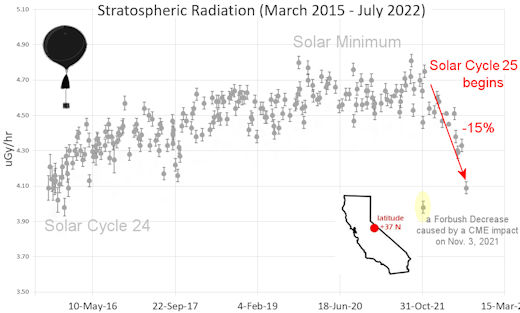
What's going on? Ironically, the radiation drop is caused by increasing solar activity. Solar Cycle 25 has roared to life faster than forecasters expected. The sun's strengthening and increasingly tangled magnetic field repels cosmic rays from deep space. In addition, solar coronal mass ejections (CMEs) sweep aside cosmic rays, causing sharp reductions called "Forbush Decreases." The two effects blend together to bring daily radiation levels down.
.Who cares? Cosmic rays are a surprisingly "down to Earth" form of space weather. They can alter the chemistry of the atmosphere, trigger lightning, and penetrate commercial airplanes. According to a study from the Harvard T.H. Chan school of public health, crews of aircraft have higher rates of cancer than the general population. The researchers listed cosmic rays, irregular sleep habits, and chemical contaminants as leading risk factors. A number of controversial studies (#1, #2, #3, #4) go even further, linking cosmic rays with cardiac arrhythmias and sudden cardiac death.
Technical notes: The radiation sensors onboard our helium balloons detect X-rays and gamma-rays in the energy range 10 keV to 20 MeV. These energies span the range of medical X-ray machines and airport security scanners.
Data points in the graph labeled "Stratospheric Radiation" correspond to the peak of the Regener-Pfotzer maximum, which lies about 67,000 feet above central California. When cosmic rays crash into Earth's atmosphere, they produce a spray of secondary particles that is most intense at the entrance to the stratosphere. Physicists Eric Regener and Georg Pfotzer discovered the maximum using balloons in the 1930s and it is what we are measuring today.
| | The official U.S. government space weather bureau |
| | The first place to look for information about sundogs, pillars, rainbows and related phenomena. |
| | Researchers call it a "Hubble for the sun." SDO is the most advanced solar observatory ever. |
| | 3D views of the sun from NASA's Solar and Terrestrial Relations Observatory |
| | Realtime and archival images of the Sun from SOHO. |
| | information about sunspots based on the latest NOAA/USAF Active Region Summary |
| | current counts of failed and deployed Starlink satellites from Jonathan's Space Page |
| | Authoritative predictions of space junk and satellite re-entries |
| | from the NOAA Space Environment Center |
| | fun to read, but should be taken with a grain of salt! Forecasts looking ahead more than a few days are often wrong. |
| | from the NOAA Space Environment Center |
| | the underlying science of space weather |
 | BestCSGOGambling is the best site for everything related to CSGO gambling on the web |
 | To find reviews of new online casino sites in the UK try The Casino DB where there are hundreds of online casino reviews complete with bonuses and ratings. Alternatively, Online-Casinos.xyz is another massive directory of online casinos listing sites for the UK and Worldwide. Casinos that offer Rupees for bonuses are very generous to Indian players. Find the best online casinos in India at AllCasinos.in Looking for a new online casino? Try Casimpo the new site dedicated to making online casino simple, or check out the new Avenger Slots Casino and Ace Online Casino with over 500 online slots and casino games. |
 | One of the most popular casino games is the Book Of Dead Slot based on ancient Egyptian text, you can find all the casinos with spins at bookofdeadslotsites.com. |
 | When looking for casinos to play online when the weather is bad, you can try casino online trucchi for Italian games. If you are not from Finland you can try the Swedish page Svenska casino online to find suitable games, check out svenskacasinoonline.net. Always check your local laws before playing with real money. |
 | Looking for sports betting companies not registered on GamStop? CasinoGap has presented a list of sites not on GamStop available for UK players. Check and bet online! Would you like to bet at sites not using GamStop? Look at a list of NonStopCasino sites for online betting that aren't on GamStop. Top-rated bookmakers ever! |
| | These links help Spaceweather.com stay online. Thank you to our supporters! |
| | | | | | |

